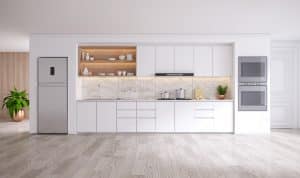How Architects Choose “Aluminium Skirting”
To make walls look clean and beautiful, it is necessary to install an “Aluminium baseboard” to cover the connection between the floor and the bottom border. Besides beauty, the skirting board protects the wall from dirty marks when mopping the floor. Currently, the design is made to store internet and LAN cables. As for cases that do not install aluminium baseboards, the bottom wall line will get dirty quickly. Today, we will share information about choosing aluminium skirting similar to how a professional architect would.
Why Use Aluminium Skirting?
If you go back to the original wall work, the skirting would have been made from wood – which would be the primary material. Because it is easy to find and can be found everywhere, but nowadays, wooden skirting is used less and less. Because after using it for a while, the wood shrinks, dries, and is difficult to clean. Therefore, the usage of an aluminium baseboard was introduced. It became a new material to use instead of wood with the following features:
- Aluminium skirting is made of metal and gives off a beautiful shine.
- Aluminium skirting is rust-resistant.
- Aluminium skirting does not fade or crack.
- Aluminium skirting is more easy-to-clean and prevents dirt buildup.
The installation process is easy and quick with the abovementioned features and a modern design. This makes an aluminium baseboard more popular and a favorite used by many architects today.
Factors to Consider when Choosing Aluminium Skirting
Always consider where the installation point will be; there are generally three main points:
- Upper skirting – to cover the joint between the wall and the ceiling. This part can be decorated with wood to add patterns.
- Center skirting – to decorate and add dimension to the wall of the house.
- Lower skirting – to cover the joint between the wall and the floor.
Consider the width by referring to the installation point:
- Floor skirting is between 6 – 10 cm. However, the width depends on the room’s style, preference, and height.
Consider the material of the skirting. Because in addition to the aluminium skirting proposed above, the wall skirting also has other materials, such as:
- For tile skirting, opt for smooth tile surfaces. Also, you might want to attach it to PVC joints to make it durable and help save money, or a tiled cornice to attach aluminum trim to make it more beautiful. Still, the disadvantage, in the long term, is the tiles might fall off.
- PVC skirting is made from PVC plastic, making it durable.
- Fiber cement skirting is made from Portland cement, cellulose fiber, and silica sand – they are non-flammable, do not shrink, and can be painted.
- Polystyrene skirting is made of high-density foam plastic. Some models can be colored with wood grain, making them look like wood. The advantage is that it doesn’t cause mold and is lighter than other skirting materials.
In addition to choosing the type of aluminium skirting board, cornice tiles are another thing that should be considered in the typical architectural style. Opt for a cornice wall because you may choose a wood pattern or a color scheme that fits with the room and makes the skirting board finish even more beautiful.

